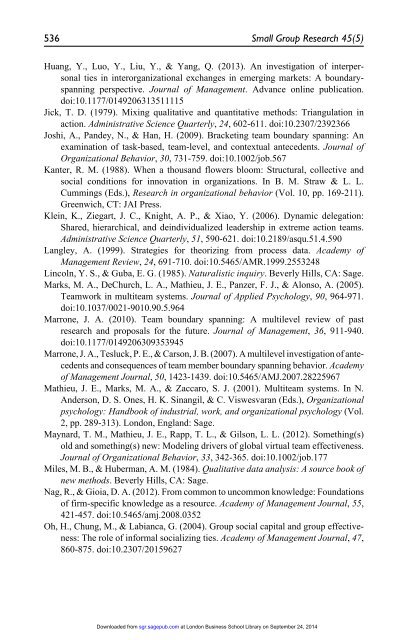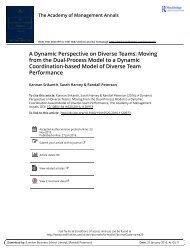The Process of Team Boundary Spanning in Multi-Organizational Contexts - Sarah Harvey, Randall S. Peterson, and N. Anand
Work teams must increasingly operate in complex environments characterized by multiple external actors beyond team and organizational boundaries. Although previous research demonstrates the importance of boundary spanning activities to team effectiveness, it reveals relatively little about the process of boundary spanning in these environments. In this article, we investigated the processes of boundary spanning across multiple external actors in 10 cross-organizational teams. We identified three sequences for reaching out to external actors: (a) moving inside-out from vertical actors inside the host organization to horizontal actors outside of the host organization, (b) moving outside-in from horizontal actors to vertical, and (c) staying-inside with vertical actors from the host organization. Our observations suggest that inside-out and outside-in sequences were more successful than simply pleasing the host organization. We build on our empirical findings to develop a process theory of how team boundary spanning activities across multiple external actors influence team effectiveness. Our research underscores the importance of a team’s interactions with actors in its external environment beyond those in an immediate supervisory role and provides insight into the dynamics of boundary spanning in multi-organizational contexts.
Work teams must increasingly operate in complex environments
characterized by multiple external actors beyond team and organizational
boundaries. Although previous research demonstrates the importance of
boundary spanning activities to team effectiveness, it reveals relatively little
about the process of boundary spanning in these environments. In this article,
we investigated the processes of boundary spanning across multiple external
actors in 10 cross-organizational teams. We identified three sequences for
reaching out to external actors: (a) moving inside-out from vertical actors inside
the host organization to horizontal actors outside of the host organization,
(b) moving outside-in from horizontal actors to vertical, and (c) staying-inside
with vertical actors from the host organization. Our observations suggest
that inside-out and outside-in sequences were more successful than simply
pleasing the host organization. We build on our empirical findings to develop
a process theory of how team boundary spanning activities across multiple
external actors influence team effectiveness. Our research underscores the
importance of a team’s interactions with actors in its external environment beyond those in an immediate supervisory role and provides insight into the
dynamics of boundary spanning in multi-organizational contexts.
Create successful ePaper yourself
Turn your PDF publications into a flip-book with our unique Google optimized e-Paper software.
536 Small Group Research 45(5)<br />
Huang, Y., Luo, Y., Liu, Y., & Yang, Q. (2013). An <strong>in</strong>vestigation <strong>of</strong> <strong>in</strong>terpersonal<br />
ties <strong>in</strong> <strong>in</strong>terorganizational exchanges <strong>in</strong> emerg<strong>in</strong>g markets: A boundaryspann<strong>in</strong>g<br />
perspective. Journal <strong>of</strong> Management. Advance onl<strong>in</strong>e publication.<br />
doi:10.1177/0149206313511115<br />
Jick, T. D. (1979). Mix<strong>in</strong>g qualitative <strong>and</strong> quantitative methods: Triangulation <strong>in</strong><br />
action. Adm<strong>in</strong>istrative Science Quarterly, 24, 602-611. doi:10.2307/2392366<br />
Joshi, A., P<strong>and</strong>ey, N., & Han, H. (2009). Bracket<strong>in</strong>g team boundary spann<strong>in</strong>g: An<br />
exam<strong>in</strong>ation <strong>of</strong> task-based, team-level, <strong>and</strong> contextual antecedents. Journal <strong>of</strong><br />
<strong>Organizational</strong> Behavior, 30, 731-759. doi:10.1002/job.567<br />
Kanter, R. M. (1988). When a thous<strong>and</strong> flowers bloom: Structural, collective <strong>and</strong><br />
social conditions for <strong>in</strong>novation <strong>in</strong> organizations. In B. M. Straw & L. L.<br />
Cumm<strong>in</strong>gs (Eds.), Research <strong>in</strong> organizational behavior (Vol. 10, pp. 169-211).<br />
Greenwich, CT: JAI Press.<br />
Kle<strong>in</strong>, K., Ziegart, J. C., Knight, A. P., & Xiao, Y. (2006). Dynamic delegation:<br />
Shared, hierarchical, <strong>and</strong> de<strong>in</strong>dividualized leadership <strong>in</strong> extreme action teams.<br />
Adm<strong>in</strong>istrative Science Quarterly, 51, 590-621. doi:10.2189/asqu.51.4.590<br />
Langley, A. (1999). Strategies for theoriz<strong>in</strong>g from process data. Academy <strong>of</strong><br />
Management Review, 24, 691-710. doi:10.5465/AMR.1999.2553248<br />
L<strong>in</strong>coln, Y. S., & Guba, E. G. (1985). Naturalistic <strong>in</strong>quiry. Beverly Hills, CA: Sage.<br />
Marks, M. A., DeChurch, L. A., Mathieu, J. E., Panzer, F. J., & Alonso, A. (2005).<br />
<strong>Team</strong>work <strong>in</strong> multiteam systems. Journal <strong>of</strong> Applied Psychology, 90, 964-971.<br />
doi:10.1037/0021-9010.90.5.964<br />
Marrone, J. A. (2010). <strong>Team</strong> boundary spann<strong>in</strong>g: A multilevel review <strong>of</strong> past<br />
research <strong>and</strong> proposals for the future. Journal <strong>of</strong> Management, 36, 911-940.<br />
doi:10.1177/0149206309353945<br />
Marrone, J. A., Tesluck, P. E., & Carson, J. B. (2007). A multilevel <strong>in</strong>vestigation <strong>of</strong> antecedents<br />
<strong>and</strong> consequences <strong>of</strong> team member boundary spann<strong>in</strong>g behavior. Academy<br />
<strong>of</strong> Management Journal, 50, 1423-1439. doi:10.5465/AMJ.2007.28225967<br />
Mathieu, J. E., Marks, M. A., & Zaccaro, S. J. (2001). <strong>Multi</strong>team systems. In N.<br />
Anderson, D. S. Ones, H. K. S<strong>in</strong>angil, & C. Viswesvaran (Eds.), <strong>Organizational</strong><br />
psychology: H<strong>and</strong>book <strong>of</strong> <strong>in</strong>dustrial, work, <strong>and</strong> organizational psychology (Vol.<br />
2, pp. 289-313). London, Engl<strong>and</strong>: Sage.<br />
Maynard, T. M., Mathieu, J. E., Rapp, T. L., & Gilson, L. L. (2012). Someth<strong>in</strong>g(s)<br />
old <strong>and</strong> someth<strong>in</strong>g(s) new: Model<strong>in</strong>g drivers <strong>of</strong> global virtual team effectiveness.<br />
Journal <strong>of</strong> <strong>Organizational</strong> Behavior, 33, 342-365. doi:10.1002/job.177<br />
Miles, M. B., & Huberman, A. M. (1984). Qualitative data analysis: A source book <strong>of</strong><br />
new methods. Beverly Hills, CA: Sage.<br />
Nag, R., & Gioia, D. A. (2012). From common to uncommon knowledge: Foundations<br />
<strong>of</strong> firm-specific knowledge as a resource. Academy <strong>of</strong> Management Journal, 55,<br />
421-457. doi:10.5465/amj.2008.0352<br />
Oh, H., Chung, M., & Labianca, G. (2004). Group social capital <strong>and</strong> group effectiveness:<br />
<strong>The</strong> role <strong>of</strong> <strong>in</strong>formal socializ<strong>in</strong>g ties. Academy <strong>of</strong> Management Journal, 47,<br />
860-875. doi:10.2307/20159627<br />
Downloaded from sgr.sagepub.com at London Bus<strong>in</strong>ess School Library on September 24, 2014
















